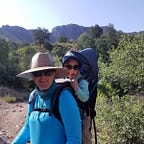Sourdough as the Ultimate Apocalypse Food
--
My idea of sourdough bread until a few weeks ago was the San Francisco variety with unbleached white bread flour. I can remember the first time I tried it. It was a white, fluffy slice slathered in local Falfurrias butter. It was tangy. It was different — in a good way.
Led by the expertise of Marguerite of Houston’s Dutch Fika, I crafted my very own loaf of sourdough bread using a typical European recipe. She guided me on the journey by providing strict instructions measured down to the gram using her rye starter. It required a food scale.
A starter is like a pet. People become attached to their starters: feeding them weekly, naming them, and even passing them to future generations as a family heirloom. Moreover, there exists a starter vault, in which every specimen comes with specific care and instructions about its organoleptic characteristics (color, texture, flavor, etc.).
Starters are a white elephant gift. You have to take care of this fermenting dough by feeding it flour and water weekly once it is graced upon you. Marguerite sold me her starter with the following instructions:
Dear friend, fellow-baker,
In this bread baking package, you will find a little jar with the rye sourdough starter from Dutch Fika. We have named it Rúne. Rúne lives on Danko rye, a heritage rye variety that originates in Poland, and filtered water. He does not have a sweet tooth, and therefore his diet does not contain honey or other types of sugars.
Rúne is Marguerite’s baby; now it’s mine. Who knew I liked four-year-old leftover dough? I am obsessed with the sticky complexity, yet simplicity of baking bread.
The beauty of sourdough is it does not require yeast as a leavening agent. In ancient times, yeast was obtained from the brewer; thus, yeast, and in turn bread-making, relied on the production of alcohol. During the COVID-19 pandemic, there has been a run on yeast, and it is in short supply in grocery stores as stress baking is on the rise.
The 21st-century farm-to-table movement has been fast-forwarded during the pandemic as short term scarcities have pushed people to analyze food supply chains. This shortage coupled with a desire to know where our food comes from accelerates a return to artisan baking. Sourdough is the ultimate apocalypse bread.
Sourdough bread requires only three ingredients — flour, water, salt. Yet, the possibilities are endless as far as the source and varietal of those three substances.
We still adopt today the European ideal of flour that dates back to Greco-Roman times: white, sifted, all-purpose wheat flour. The book Bread, a Global History, notes that ancient Greek physician, Galen, wrote that “white bread was favoured over bran breads. Loaf breads were favored over flatbreads. Wheat was favoured over all other grains. Medical reasons were articulated for the preferences, which were probably not coincidentally aligned with what was by then already long historic precedent — the rich preferred light, white, wheat breads to dense, dark, bran-filled ones.” “In pre-industrial milling systems 50 percent of the grain, or much more, might have been sifted away to achieve white flour. Food scarcity virtually dictated that the consumption of white bread was reserved for the elites.” Most food trends start in this way, think of quinoa as a grain once bequeathed to Michelin star chefs. It can now be found at Wal-Mart.
Access to white flour changed from upper-class food to everyday sustenance during the Industrial Revolution. Technological advances allowed for the milling of cheap, white flour, replete of the germ and bran from the wheat grain. In fact, given the lack of nutrition in white flour, millers enrich the flour with vitamins. The reason white flour is king is its shelf life and stability.
Today, the germ and bran go to enriching other foods as well as to feeding animals. This practice is a carryover from the Medieval times when “horse-breads were flatbreads made with bran stuck together with rye flour, also sometimes containing chaff, straw, and the waste from the bakery floor. These breads were fed to horses to enable them to do strenuous work like pulling carts or trotting long distances.” Needless to say, because of their cheap cost, “it was sometimes eaten by the poor as it was one-third of the price of the cheapest wholegrain loaf.” It is ironic, that in these times, livestock and the impoverished were reaping the nutritional benefits of whole-grain loaves.
The current bread du jour is not crustless white bread slathered with PBJ, but whole grain artisan loaves composed from heritage grains.
It takes large cultural events to change society. Just as we saw the tech evolution change food in the early 1900s and limit biodiversity, this century we will see a return to examining many varietals of grains and nuts (and other foodstuffs like acorns…).
I suspect that post-pandemic and health-conscious consumers will demand a search to find better nutrition and less food waste to feed our growing world population.
Barton Springs Mill is a shining example of a company pioneering this movement. They are selling heirloom grains, working with Texas farmers to grow them, and milling them for bakers. I have tried their Turkish Red, Ruby Lee, and Rouge de Bordeaux wheat varieties paired with Danko Rye, and I look forward to more experimentations.
There are a few other grain providers dispersed around the US, most notable are the Tehachapi Grain Project, Anson Mills, and Community Grains. Washington State University Bread Lab is also on the leading edge of wheat breeding.
Give us our daily bread,
Mimi
